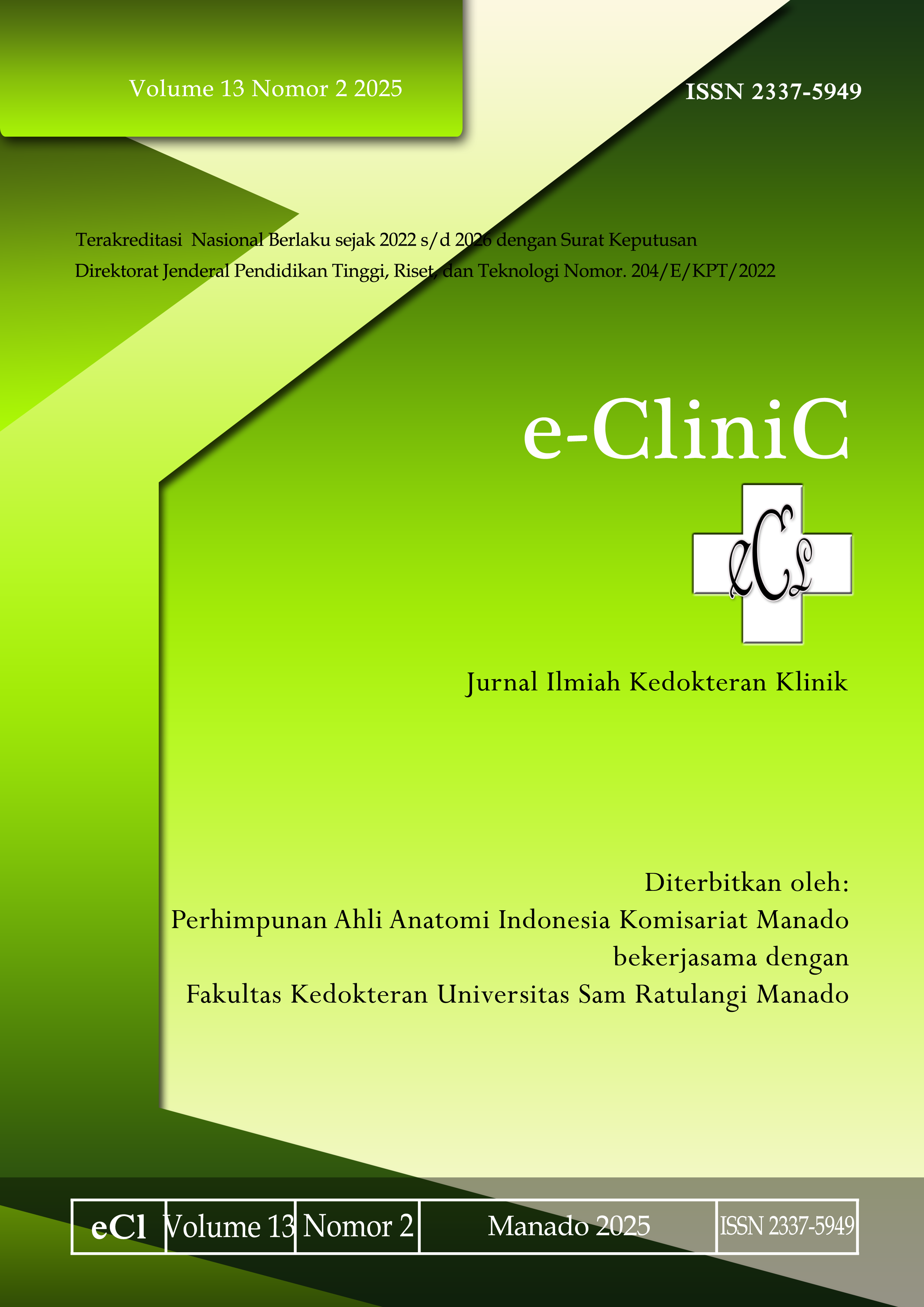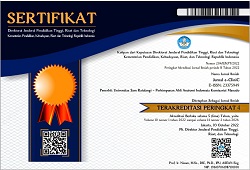Profil Penggunaan Antibiotik pada Pasien Sepsis dan Syok Septik di Ruang Perawatan Intensif Prof. Dr. R. D. Kandou Manado
DOI:
https://doi.org/10.35790/ecl.v13i2.60875Abstract
Abstract: Gram-negative and gram-positive bacteria are common causes of sepsis and septic shock, therefore, treatment often uses broad spectrum antibiotics. This study aimed to determine the types of antibiotics used, the suitability of antibiotics with etiology, and the average length of antibiotic use in sepsis and septic shock patients at Prof. Dr. R. D. Kandou Hospital Manado from July 2022 to June 2023. This was a descriptive and retrospective study using patients’ medical records. The results showed that the use of antibiotics in sepsis and septic shock included monotherapy and combination therapy. The most common antibiotics for monotherapy was levofloxacine (14.3%) in sepsis, and meropenem (8.7%) in septic shock. The most common combination for sepsis was meropenem-levofloxacine (6.7%) and meropenem-metronidazole (6.7%), meanwhile for septic shock was meropenem-levofloxacine (16.5%). Of the 91 sepsis patients, only 15 had the causative germs; 10 (9.62%) antibiotics did not match the etiology, eight (7.84%) did. In septic shock, of 91 patients, five patients had the causative germs; four (4.44%) antibiotics were according to etiology, three (3.37%) were not appropriate. The average use of antibiotics was one day, with an average value of 3.06 for sepsis and 2.24 for septic shock. In conclusion, in patients with sepsis and septic shock, the monotherapy is levofloxacine and meropenem, while the combination therapies are meropenem-levofloxacine and meropenem-metronidazole. Antibiotics appropriate to the etiology in sepsis and septic shock sepsis have nearly the same number with those inappropriate to etiology. The average duration of antibiotic use for both sepsis and septic shock is one day.
Keywords: antibiotics; sepsis; septic shock; profile of antibiotics usage
Abstrak: Bakteri Gram-negatif dan Gram-positif merupakan penyebab umum sepsis dan syok septik, sehingga pengobatannya sering menggunakan antibiotik spektrum luas. Penelitian ini bertujuan untuk mengetahui jenis antibiotik yang digunakan, kesesuaian antibiotik dengan etiologi, rerata lama penggunaan antibiotik pada pasien sepsis dan syok septik di RSUP Prof. Dr. R. D. Kandou Manado periode Juli 2022–Juni 2023. Jenis penelitian ialah deskriptik retrospektif menggunakan data rekam medis pasien sepsis dan syok septik. Hasil penelitian mendapatkan penggunaan antibiotik pada sepsis dan syok septik meliputi monoterapi dan kombinasi. Antibiotik yang umum digunakan untuk monoterapi ialah levofloxacine (14,3%) pada sepsis, dan meropenem (8,7%) pada syok septik; untuk kombinasi meropenem-levofloxacine (6,7%) dan meropenem-metronidazole (6,7%) pada sepsis dan meropenem-levofloxacine (16,5%) pada syok septik. Dari 91 pasien sepsis, hanya 15 yang memiliki kuman penyebab; 10 (9,62%) antibiotik tidak sesuai etiologi, dan delapan (7,84%) sesuai. Pada syok septik, dari 91 pasien, lima memiliki kuman penyebab; empat (4,44%) antibiotik sesuai etiologi, dan tiga (3,37%) tidak sesuai. Rerata penggunaan antibiotik terbanyak ialah satu hari, dengan nilai rerata 3,06 untuk sepsis dan 2,24 untuk syok septik. Simpulan penelitian ini ialah antibiotik yang banyak digunakan pada pasien sepsis dan syok septik sebagai monoterapi yaitu levofloxacine dan meropenem, sedangkan untuk kombinasi ialah meropenem-levofloxacine dan meropenem-metronidazole. Antibiotik yang sesuai etiologi baik pada sepsis maupun syok septik hampir sama banyak dengan yang tidak sesuai etiologi. Rerata lama penggunaan antibiotik baik sepsis maupun syok septik ialah satu hari.
Kata kunci: antibiotik; sepsis; syok septik; profil penggunaan antibiotik
References
Singer M, Deutschman CS, Seymour C, Shankar-Hari M, Annane D, Bauer M, et al. The third international consensus definitions for sepsis and septic shock (sepsis-3). JAMA. 2016;315(8):801-10. Doi: https://doi:10.1001/jama.2016.0287
WHO. Global report on the epidemiology and burden of sepsis: Current evidence, identifying gaps and future directions. Geneva: World Health Organization; 2020. Available from:https://iris.who.int/bitstream/ handle/10665/334216/9789240010789-eng.pdf?sequence=1
Purba AKR, Mariana N, Aliska G, Wijaya SH, Wulandari RR, Hadi U, et al. The burden and costs of sepsis and reimbursement of its treatment in a developing country: An observational study on focal infections in Indonesia. International Journal of Infectious Diseases (IJID). 2020;96:212-16. Doi: 10.1016/j.ijid.2020. 04.075
Sudarmono P, Aman T, Arif M, Syarif AK, Kosasih H, Karyana M, et al. Causes and outcomes of sepsis in
Southeast Asia: a multinational multicentre cross-sectional study. The Lancet Global health. 2017;5(2):157-67. Doi: https://doi.org/10.1016/S2214109X(17)30007-4
Tambajong RN, Lalenoh DC, Kumaat L. Profil penderita sepsis di ICU RSUP Prof. Dr. RD. Kandou Manado periode Desember 2014 - November 2015. Jurnal Ilmu Kedokteran Klinik. 2016;4(1):452-7. Doi: https://doi.org/10.35790/ecl.v4i1.11011
Millizia A. Penatalaksanaan sepsis. Jurnal Kedokteran Nanggroe Medika. 2019;2(3):28-36. Doi: https://doi.org/10.35324/jknamed.v2i3.96
Evans L, Rhodes A, Alhazzani W, Antonelli M, Coopersmith CM, French C, et al. Surviving sepsis campaign: international guidlines for management of sepsis and septic shock 2021. Intensive Care Med J. 2021;47(11):1181-247. Doi: https://doi:10.1007/s00134-021-06506-y
Kemenkes RI. Peraturan Menteri Kesehatan Republik Indonesia Tahun 2021: Pedoman penggunaan antibiotik. Jakarta: Menteri Kesehatan RI; 2021. Available from: https://yankes.kemkes.go.id/unduhan/ fileunduhan_1658480966_921055.pdf
Nugraheni AY, Putri MS, Saputro AY. Evaluasi ketepatan antibiotik pada pasien sepsis. Jurnal Farmasi Indonesia. 2021;18(2);194-05. Doi: 10.23917/pharmacon.v18i2.16635
Kemenkes RI. Keputusan Meneteri Kesehatan Republik Indonesia Tahun 2017: Pedoman nasional pelayanan kedokteran tata laksana sepsis. Jakarta: Menteri Kesehatan RI; 2017. Available from: http://hukor.kemkes.go.id/uploads/produk_hukum/KMK_No._HK_.01_.07-MENKES-342-2017_ttg_Pedoman_Pelayanan_Kedokteran_Tata_Laksana_Sepsis_.pdf
Yudhorini LT, Komalasari Y, Azrifitria, Lathifah. Evaluasi penggunaan antibiotik pada pasien sepsis dengan Covid-19 di RSUP Fatmawati Jakarta. Jurnal Ilmu Kesehatan. 2022;1(1):1-13. Doi: 10.58815/jfklin.v1i1.13
Ekayana E, Fithrie A, Nasution IK. Gambaran bakteri dan sensitivitas antibiotik pada pasien stroke dengan sepsis di ruang neurologi RSUP Haji Adam Malik Medan. Neurona Journal. 2019;36(2):106-12. Doi: https://doi.org/10.52386/neurona.v36i2.62
Astutik AW, Annisa N, Rusli R, Ibrahim A. Kajian kesesuaian pemilihan antibiotik empiris pada pasien sepsis di Instalasi Rawat Inap RSUD Abdul Wahab Sjahranie Samarinda. Jurnal Farmasi Indonesia. 2017;18(2):38-47. Doi: https://doi.org/10.30872/mpc.v5i.386
Sugiyono, Padmasari. Hubungan kesesuaian antibiotik definitif dengan clinical outcome pada pasien sepsis ulkus diabetik di RSUD Kota Yogyakarta. Jornal Fitofarmaka. 2019;9(1):56-63. Doi: 10.33751/jf.v9i1.1261
Wirajaya MKM, Dewi NMUK. Analisis ketidaklengkapan rekam medis pasien rawat inap di Rumah Sakit Dharma Kerti Tabanan. Jurnal Administrasi Rumah Sakit Indonesia. 2020;6(1):11-20. Doi: http://dx.doi.org/10.7454/arsi.v6i1.3553
Firmansyah J, Wahyuni A, Ratna MG, Carolia N. Hubungan sensitivitas antibiotik terhadap luaran pasien sepsis di Ruang ICU RSUD Dr. H. Abdul Moeloek Provinsi Lampung tahun 2018-2021. Jurnal Medula. 2022;12(2):231-37.
Downloads
Published
How to Cite
Issue
Section
License
Copyright (c) 2025 Feysira C. E. P. Kowel, Diana C. Lalenoh, Mordekhai L. Laihad

This work is licensed under a Creative Commons Attribution-NonCommercial 4.0 International License.
COPYRIGHT
Authors who publish with this journal agree to the following terms:
Authors hold their copyright and grant this journal the privilege of first publication, with the work simultaneously licensed under a Creative Commons Attribution License that permits others to impart the work with an acknowledgment of the work's origin and initial publication by this journal.
Authors can enter into separate or additional contractual arrangements for the non-exclusive distribution of the journal's published version of the work (for example, post it to an institutional repository or publish it in a book), with an acknowledgment of its underlying publication in this journal.
Authors are permitted and encouraged to post their work online (for example, in institutional repositories or on their website) as it can lead to productive exchanges, as well as earlier and greater citation of the published work (See The Effect of Open Access).







